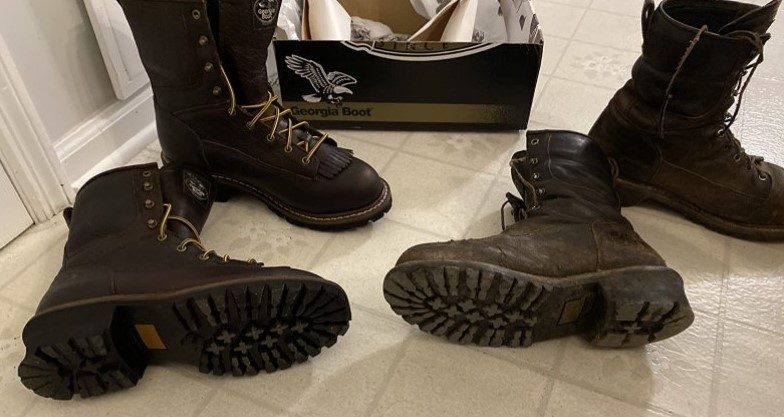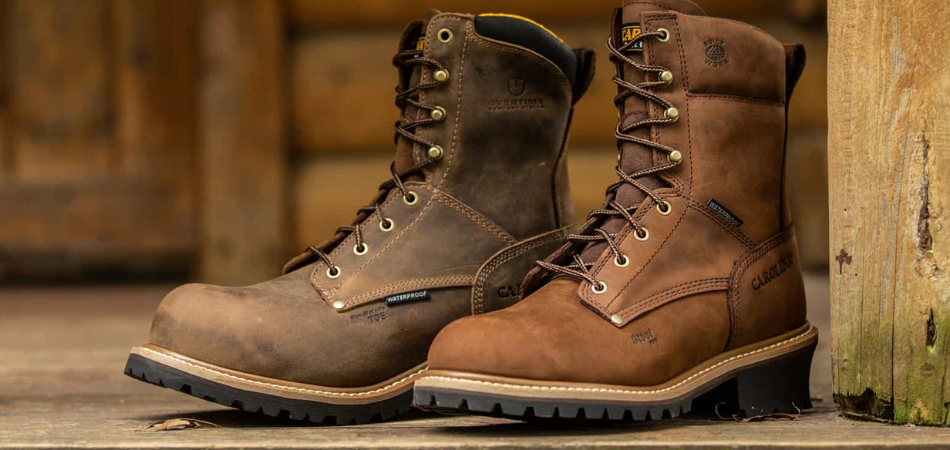If you are looking for a pair of shoes to put on when working, you probably have heard about work boots, and you also may have wondered why these boots have high heels. As you read this article, you will discover that almost everything revolves around safety, health, and comfort.
So, why do work boots have heels? Work boots have heels in order to: keep you balanced, comfortable, provide proper elevation, help you in climbing, and other health reasons.
Let’s go back in time; during the latter 19th century, logger boots were worn during wood traction, timber rafting, where loggers were given one pair of boots as part of their pay, which was expected to last a year. This high heel design has been passed on from traditional logger boots, caulked boots to the newer generation work boots. Surprisingly, several industries have embraced it for its many advantages. The raised heels of a work boot are significant and have various impacts across different hobbies and professions.
For example, bikers love them for the high heels grip firmly on the bike; farmers and ranchers, on the other hand, love the traction that heeled work boots provide when walking on the muddy ground. In this article, we dig deep to find out why work boots have high heels.
Should My Work Boots Have a Raised Heel?
The slight elevation that work boots provide is more beneficial than its downside, and that’s what really matters. So, should your work boots have a raised heel? The answer is yes. The raised heels of work boots provide excellent ankle support if you are working on bumpy or unlevel ground.
In each step you make, they offer stability and a firm grip for you not to stumble over. They also act as shock absorbers and additionally prevent foot and back injuries. Work boots are designed to give the wearer excellent arch support during strenuous work.
5 Reasons Why Work Boots Have Heels
Work boots are a special kind of high-performance footwear. They are meant to keep the wearer’s foot safe. If you are wondering why work boots have heels, well, we’ve got a lineup of answers for you.
As mentioned before, the raised heels of work boots serve several beneficial purposes. It is important to note that heeled work boots are life-saving footwear in some work environs. Let us take a look at these five reasons why work boots have high heels:
1. Good for Health
Foot pain is a common problem to those working in the logging industry or those whose jobs demand standing for long hours. Raised heels are designed to prevent foot pain. These raised heels take away the pressure from the ball of foot, saving the wearer foot pain after a long day of work.
High heel work boots help improve body posture and save you from experiencing shin splints. Shin splints develop if you do not put on proper shoes; this leads to severe ankle pains.
Keeping your back straight is another reason why work boots are good for your health. This keeps your torso balanced, and for this reason, you can work for long hours without feeling any pain. It helps maintain a straight posture when walking. Wearing work boots with high heels helps mitigate body pain issues effectively.
2. Helps in climbing
You may never have been paying much attention to this, but your heel is the first point of contact with the ground while walking. For this reason, your heels experience sharp pains after prolonged hours of wearing thin flat-soled footwear. High heel work boots are designed to counter this problem. How? Work boots have thick raised heels that dig in firmly to the ground when you go up a slope. As a result, the raised heels provide padding that prevents pain and offers excellent traction preventing you from slipping on slippery surfaces.
For instance, in the logging industry, the ground can be so unpredictable and may involve climbing up and down. A high-heeled work boot will keep you stable as you climb up and still prevent you from skidding while you come down. It doesn’t matter whether it is on rocky, muddy, or gravel; heeled work boots will help you navigate your way incredibly well.
3. Keeps Balance
Body balance is vital for safety. You don’t want to work in an environment where you keep stumbling to the ground each time you carry a load or push something. Undoubtedly, most footwears are the primary reason for imbalance. However, work boots are specially engineered to keep the wearer’s balance solid on any ground.
Heeled work boots have your center of gravity pushed forward, thus giving you a proper balance and reducing the risk of falling. Some of your body weight will be supported by the ball of each foot, giving you a solid balance.
4. Comfortable
Most people tend to think that the raised heel of work boots can cause foot discomfort. That’s not the case. Unlike stilettos, work boots heels are not too high. They are slightly elevated with a broad base giving the wearer perfect comfort while working or walking around. If you are the type of person who works on your feet all day long, you can attest that the heel part of your foot can hurt if you do not put on proper footwear. Work boots are designed with this in mind. Their elevated sole is meant to give you comfort since it supports the whole foot generally.
If you have a flat foot, you might find high-heeled work boots uncomfortable to wear and work with, in some cases. It shouldn’t worry you anyways, since there are comfortable work boots for flat feet available. All said, work boots with heels will keep your feet relaxed for a very long time so that you can stay focused on work rather than discomfort on your feet.
5. Provides Proper Ground Elevation
Whether working at home or your workplace, have you ever accidentally stepped on a sharp nail or pin that went through the sole of shoes straight into your foot? That can be so painful. Work boots are made with about an inch thick sole; this is thick enough to keep your foot protected from such incidents.
Take a look at workers who work on muddy or wet ground; high-heeled work boots are their ultimate savior. The raised sole helps keep them dry and protected from the muddy ground. Furthermore, work boots have rugged and heavy treaded soles, which is advantageous to those working on the uneven ground since it provides an outstanding ground grip.
Other Reasons:
High-heeled work boots are so advantageous thus cannot be limited to only five reasons. There is so much in store to talk about; however, we’ll add a few more reasons that are still very important and worth noting:
Increased Durability
It’s no secret that your heeled work boots will literally outlast any other footwear in your closet. The thick raised sole on heeled work boots is built to last and endure the extra stress from different types of surfaces. They don’t wear or tear down quickly.
Skid Resistant
Heeled work boots feature deep lugs, consequently providing more traction than ordinary footwear. Whether on Slippery or muddy ground, the slip or skid resistance ability of high-heeled work boots is highly effective. It saves you from accidental falls or ankle twists.
Prevents Plantar Fasciitis
Plantar Fasciitis is a condition caused by swelling of the tissues on the sole of your foot. When your heels are stressed, plantar fasciitis is likely to occur. Fortunately, high-heeled work boots, by far, reduce the risk of developing plantar fasciitis. These boots have a cushioning material that significantly reduces stress on your foot. It means you can stand and work for long hours without experiencing any pain.
Final Thoughts
Work boots design was inspired by the original logger boots, caulked boots, used in the 19th century by timber workers. Today, many industries and people have embraced its elegant design and continue to enjoy the many benefits of these raised heels work boots. This article has outlined the reasons why work boots have high heels. To sum up, High heeled work boots are engineered for safety and optimal support of your feet and body in general. Worth noting, they are perfect for outdoor duties. If your job requires you to move around on uneven ground, these are the right shoes for you.


